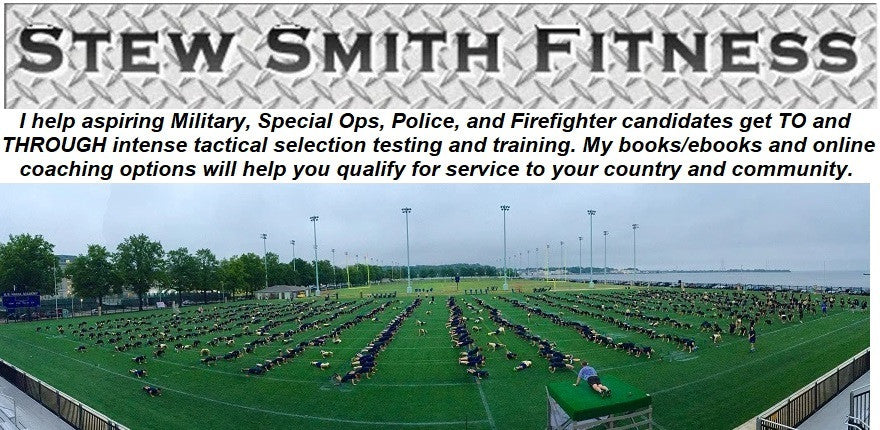Soldiers often contact me to update me on what they are doing for physical training. Their fitness training cycles usually vary a great deal from basic training to maintenance training while overseas or preparing to go overseas. Recently, in an AP article that was featured at Today Online, many combat veterans are adding sprints, agility drills and core exercises to build a better equipped combat soldier.
Shorts bursts of sprinting carrying combat loads of 50-75 lbs or more is often the daily requirement when on combat patrols. Preparing for that eventuality can be as simple as setting up some cones to run through with your gear or as complex as obstacle courses like the USMC Combat Fitness Test.
The USMC Combat Fitness Test is the Marine Corps answer to this growing need of combat ready fighters. But, if you are pre-training to join the military, here are some ideas for you to try to build a solid base of core strength and speed / agility prior to joining the military. Active duty personnel seeking to create their own programs should consider adding these types of workouts into their regular PT programs as well.
Basic Foundation of Fitness – Your basic PT / run will cover this one. You still want to do your pushups, situps, pull-ups, dips and some form of cardiovascular fitness like running, rucking, swimming, etc. If you neglect these, it is difficult to add the strength, speed, and agility required in a combat setting. One of my favorite (more advanced) cardio / core / leg workout mixes is the Run/Leg PT:
Repeat 6-8 times (2-3 times per week)
Run or ruck ¼ mile at goal pace*
**Squat – 20
Lunges – 10/leg
Flutter kicks – 25
*goal pace = pace you want for 2-3 mile run – ie a 14 min 2 mile run = a 7 min mile, 3:30 ½ mile, and a 1:45 ¼ mile running pace. For ruck always keep the pace between 12-15 min per mile with 50+ lbs in back pack
** add weight using a back pack or dumbbells / kettlebell and swing the weight like chopping wood while you squat and lunge. See Wood Chopper Squats and Lunges pictured:
Wood Chopper Squat with Dumbbell - Hold the dumbbell with both hands over your head in the standing position. Drop to a squat position and at the same time swing your arms down like you were using an ax. Keep your back straight, head up. Use your legs to get the dumbbell over your head by returning to the standing position forcefully.
Wood Chopper Lunges with Dumbbell - Hold dumbbell or medicine ball with both hands and step forward to a down lunge position. Swing dumbbell to the outside of the leg the stepped forward as if you were chopping wood with an ax.
Additional Core Workouts – As the wood choppers will work the core as well as your legs, one of the best CORE training devices I have ever used is the TRX. If that does not interest you, I would consider working the lower back and upper back with standard calisthenics exercise. See Lower Back Plan - FREE – it works well to build a foundation on which to add more dynamic exercises like the above woodchopper squats and lunges and some of the Olympic lifts. You want to build the core of the body both horizontally and vertically – meaning it is fine to do leg lifts and situps for abs, but you also want to develop the torso through lifting and movement weights like you will be doing with 50-75lb back packs. By working your core (abs, lower back, upper back, chest/shoulders), you will help to build proper posture and alignment that will better carry you when running / patrolling with weight.
Agility Drills – Besides doing 40-60m sprints, adding some sudden stop / starts into the running workout will help you build the speed / agility you need for your future training.
a) Illinois Agility Test – This is one of the most common in law enforcement circles and requires the students to run fast, stop quickly, change directions, and move the body from a laying position to a running stride as quickly as possible. The course is 30 feet long and 15 feet wide. Place four cones 10 feet apart at the 7.5 ft. line and the first and fourth cone at the zero and 30 ft line. A picture is worth a 1000 words.
b) M drills – This is a simple use of cones 10-20yds apart in the shape of an “M”. You can run this forward, backward, always looking in one direction as well as starting and stopping the test while in the prone position (on the ground).
c) T- Drill – This one is straight out of the NFL combine that measures agility and takes only a few seconds to accomplish. Always looking in the same direction you can start on your back – get up and run forward 10yds, left side step 5yds, right side step 10yds, left side step 5yds to center, back step 10yds to start position.
